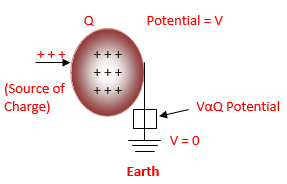Capacitor Introduction
Description:
A device to store electrical energy by storing charge is called a capacitor.
To understand how a capacitor stores energy, take a metal plate having Zero potential initially with respect to earth (Potential of earth is taken as 0).

Let, some charges are carried to the metal plate using battery or dynamo or using other source of charge. As more number of charges are carried, each charges experience repulsion due to the existing charge within the plate. in order to displace charges within the metal, more work is needed to be done on each consecutive charge against the force of repulsion. Hence each charge locked inside the metal, stores energy with itself. This is how a metal plates of capacitor stores energy by storing charges.
We know that potential of a conductor is directly proportional to Total charge enclosed inside the conductor (V α Q). so, If a potentiometer is connected with the metal plate and the number of charge is increased within the metal, then reading of potentiometer will show increase in potential. The increase in reading of voltmeter indicates the increase in number of charge.

Let the process of giving charge to the metal stops after some time and let the charge acquired by the conductor be Q . This capacitor now has energy to work. In this case, the potential (V) acquired by the capacitor with respect to earth is:
V = 1/4πε0 Q/R
We have learnt that a positive charge always flows from higher potential to lower potential. Now, if a bulb is connected with the capacitor having potential (V) and the complete system is connected to earth where potential is zero, the charge starts flowing from the capacitor towards earth through the bulb. As charge reaches the bulb, it glows. This bulb glows by using stored energy of capacitor.

